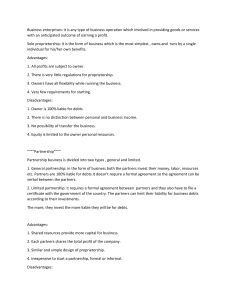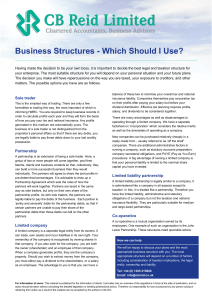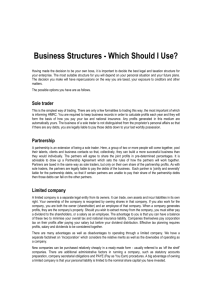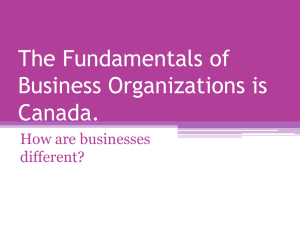Company Structure - Georgian College
advertisement
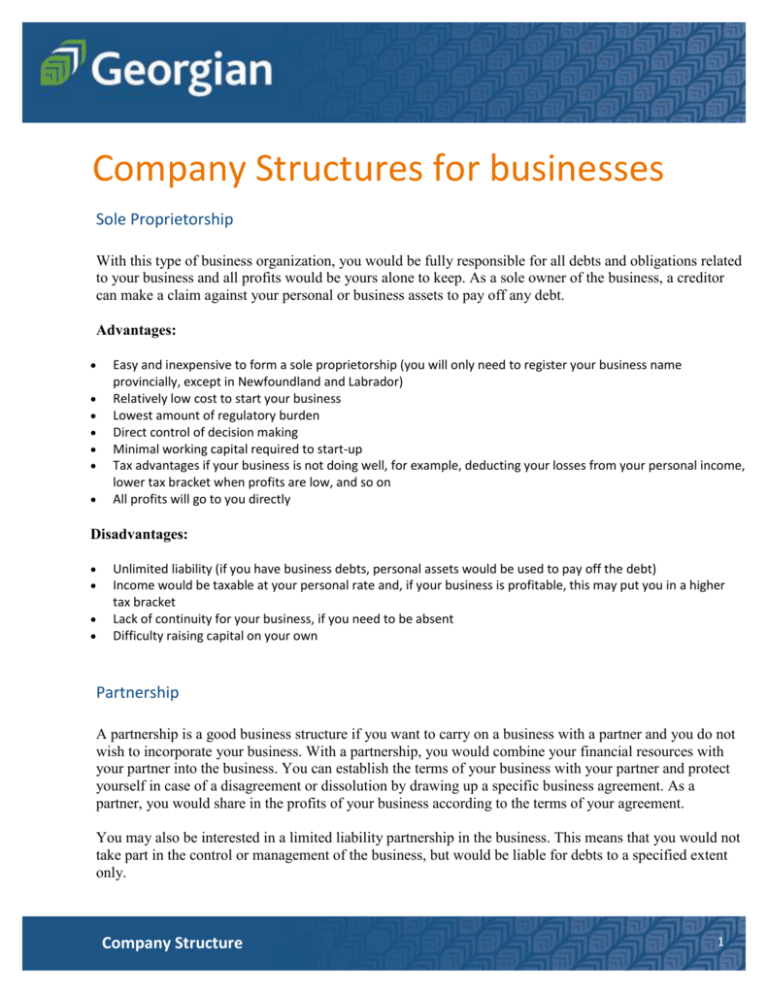
Company Structures for businesses Sole Proprietorship With this type of business organization, you would be fully responsible for all debts and obligations related to your business and all profits would be yours alone to keep. As a sole owner of the business, a creditor can make a claim against your personal or business assets to pay off any debt. Advantages: Easy and inexpensive to form a sole proprietorship (you will only need to register your business name provincially, except in Newfoundland and Labrador) Relatively low cost to start your business Lowest amount of regulatory burden Direct control of decision making Minimal working capital required to start-up Tax advantages if your business is not doing well, for example, deducting your losses from your personal income, lower tax bracket when profits are low, and so on All profits will go to you directly Disadvantages: Unlimited liability (if you have business debts, personal assets would be used to pay off the debt) Income would be taxable at your personal rate and, if your business is profitable, this may put you in a higher tax bracket Lack of continuity for your business, if you need to be absent Difficulty raising capital on your own Partnership A partnership is a good business structure if you want to carry on a business with a partner and you do not wish to incorporate your business. With a partnership, you would combine your financial resources with your partner into the business. You can establish the terms of your business with your partner and protect yourself in case of a disagreement or dissolution by drawing up a specific business agreement. As a partner, you would share in the profits of your business according to the terms of your agreement. You may also be interested in a limited liability partnership in the business. This means that you would not take part in the control or management of the business, but would be liable for debts to a specified extent only. Company Structure 1 When establishing a partnership, you should have a partnership agreement drawn up with the assistance of a lawyer, to ensure that: You are protecting your interests That you have clearly established the terms of the partnership with regards to issues like profit sharing, dissolving the partnership, and more That you meet the legal requirements for a limited partnership (if applicable) Advantages: Easy to start-up a partnership Start-up costs would be shared equally with you and your partner Equal share in the management, profits and assets Tax advantage, if income from the partnership is low or loses money (you and your partner include your share of the partnership in your individual tax return) Disadvantages: Similar to sole proprietorship, as there is no legal difference between you and your business Unlimited liability (if you have business debts, personal assets would be used to pay off the debt) Hard to find a suitable partner Possible development of conflict between you and your partner You are held financially responsible for business decisions made by your partner (for example, contracts that are broken) Corporations Another type of business structure is incorporation. Incorporation can be done at the federal or provincial level. When you incorporate your business, it is considered to be a legal entity that is separate from the owners and shareholders. As a shareholder of a corporation, you will not be personally liable for the debts, obligations or acts of the corporation. When making such decisions, it is always wise to seek legal advice before incorporating. Advantages: Limited liability Ownership is transferable Continuous existence Separate legal entity Easier to raise capital Possible tax advantage as taxes may be lower for an incorporated business Disadvantages: A corporation is closely regulated More expensive to incorporate than a partnership or sole proprietorship Extensive corporate records required, including shareholder and director meetings, and documentation filed annually with the government Possible conflict between shareholders and directors 2 3



